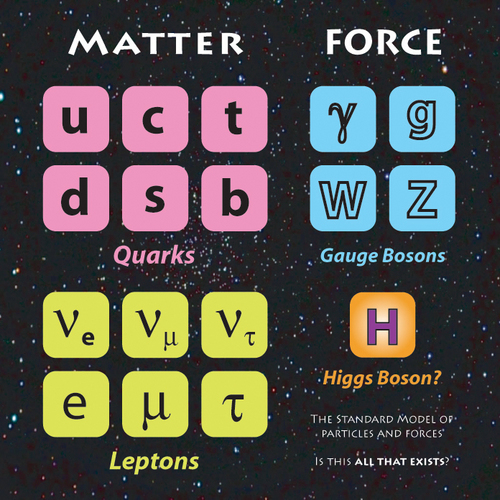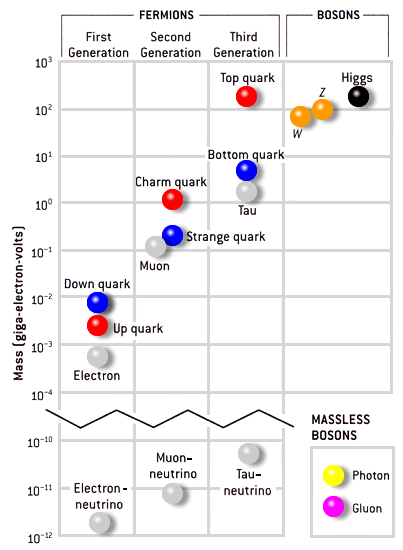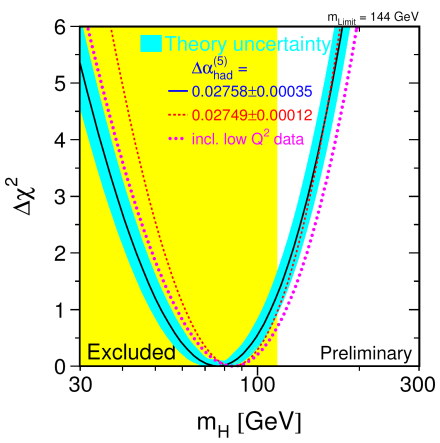"We hates it, we hates it, we hates it for ever!" -Gollum, from the Hobbit
Don't get me wrong. The Higgs is an absolutely wonderful mechanism, and I've very optimistic that the last particle of the standard model -- the Higgs Boson -- will be found over the next few years, either at the Large Hadron Collider or, if experimenters get very lucky, at Fermilab!

As far as particle physics goes, the Higgs would be unlike any other fundamental particle we know of. While all the other particles have a spin, or an intrinsic angular momentum, the Higgs is predicted to be spin-0, or spinless.
While all the other bosons in the Universe -- the photon, the gluons, and the W's and Z -- are vector particles, the Higgs is predicted to be a fundamental scalar, the only one of its kind.
And finally, as far as we know, the Higgs has unique coupling properties; something no other particle has. The Higgs must couple to all of the quarks, the heavy leptons (but maybe not the neutrinos), and the W's and Z, but not the photon or the gluons.

Why's that? Because the Higgs is incredibly useful -- indeed, it seems to be the only reasonable explanation -- for where mass comes from. (And if you're a technicolor enthusiast, please read about flavor changing neutral currents before posting in the comments.)
And realistically, this is what we love the Higgs mechanism for.

The Higgs explains the existence of mass better than any other theory we have, and it would be very surprising if the Higgs Boson didn't show up at the LHC.
But you might be compelled to ask the following, "Why does the Higgs give the values of mass it gives to the 13-to-16 (depending on whether it gives neutrinos mass) particles in the standard model with mass?"

And in my opinion, that's the real horror of it all. The mass of the electron, the masses of the up and down quarks (that make up the proton and neutron), the masslessness of the photon and gluons, and even the mass of the Higgs itself are not predicted by the standard model!
In fact, if you look at the best predictions we have for the mass of the Higgs, we know that it isn't quite there!

Now, there might be interesting physics beyond the Standard Model, but realistically, we'd have to be very fortunate to have experimental access to that physics.
The great nightmare of people interested in particle physics is that the standard model works too well. That the Higgs exists somewhere between 120 and 140 GeV, that there's no supersymmetry or extra dimensions or composite Higgs or technicolor or anything surprising.
And this would mean that we'd never understand why the Higgs couples the way it does, or why the particles in the Universe have the masses that they do; the best we'd be able to say is, "They just do."
So I'm hopeful that they don't find only the Higgs, because if they do, we could be living through the last hurrah of particle physics, and there's too much that we still need to know! Here's hoping...

Could you please add an explanation how the Higgs becomes responsible for other particles having mass? It's always a bit confusing how the heaviest particle is responsible for the mass of an electron 6 orders of magnitude lighter.
Gordon Freeman with a helmet? Your'e not making sense, man.
What do you make of this report about physicists finding a forth Neutrino flavor? One that could explain dark matter.
http://blogs.discovermagazine.com/80beats/2010/11/03/did-physicists-fin…
NewEnglandBob,
I'm over a month ahead of you. http://scienceblogs.com/startswithabang/2010/09/the_new_nu_news.php
Mu,
It's a very difficult concept to explain in a blog post. If I'm feeling up to it, maybe I'll give it a shot soon.
Stupid (stupidest?) question: What exactly is mass in the sense used here? My Joe Schmoe idea of a thing with mass is something that has momentum or that is influenced by gravity or weighs something when put on a scale. :) But photons have both momentum and are affected by gravity, but don't have mass.
Bjarni: Your Joe-Schmoe idea of mass is fine. But remember that the energy a particle carries also has similar properties, thanks to E=mc². A photon that was completely at rest would have no momentum and no mass.
There is a tremendous misunderstanding in the popular physics sphere about what the Higgs does with respect to mass, and I think you ought to make this point more clear in the future. That is, the mass of all the baryonic matter in the universe *has nothing to do with the Higgs*. The Higgs does not produce mass nor have any fundamental role in the origin of inertia; it simply provides a mechanism for elementary particles to pick up an *effective* mass. But the mass of protons and neutrons has nothing to do with the Higgs (almost nothing; the quark masses are negligible in these systems); their mass comes from their binding energy, not the Higgs. So the mass of me, you, the earth, the sun, has virtually nothing to do with the Higgs.
@Bjarni: The momentum of light is a quantum mechanical effect: the momentum of a photon is hbar * k where the wavevector k has magnitude 2π/λ and points in the direction the photon is moving. So Brian's explanation is not quite right: the photon will move at the speed of light no matter what, but for its momentum to vanish its wavelength would have to be infinitely long.
The gravitational effect is due to the warping of space in general relativity. The photon still moves along a geodesic path, which is a straight line in plane geometry, but becomes curved in the vicinity of a mass.
I know it's a complex subject but I'd love an explanation, too. I have an awesome book on electroweak theory, Bruce Schumm's "Deep Down Things: The Breathtaking Beauty of Particle Physics", which gets into the Higgs mechanism towards the end. But because it is primarily about electroweak theory and probably also because it's a book for the layperson, its explanation of the Higgs field's screening effect works very well for my brain when it comes to virtual W and Z particles being short-ranged, but doesn't seem like it'd explain much else, like rest mass energy. I've been looking for an explanation I can wrap my head around ever since (and I first read the book something like 3 years ago!)
Nice post.
Aron is correct.
Mu the quotes below might help.
The lightness of Being, Frank Wilcek, 2008,
preview book of the Nobel Laureate of mass at http://books.google.com/
quotes follow:
pg 201, "the mass of the proton arises from the energy of the quarks and gluons it contains, according to Einstein's second law. (m=E/c^2)...the u and d quarks do in fact have only tiny masses, much smaller than the mass of the proton, so their contribution to the proton's mass is very small...
pg 192, "We assumed that the Grid--the entity that in everyday life we consider empty space--is a multilayered, multicolored superconductor. We assumed the the world contains the extra quantum dimensions required to support supersymmetry. And we boldly took the laws of physics, supplemented with these two "super" assumptions, up to energies and down to distances far beyond where we've tested them directly."
pg 213, "Grid superconductivity differs from conventional superconductivity..."
pg 214, "No known form of matter can supply such supercurrents. On the other hand, it's easy to invent new Higgs-like fields that do the job."
pg 194, "we can estimate how much energy we need to concentrate in order to break off individual pieces (quanta) of the condensate--or, in more prosaic terms, to make the Higgs particle or particles or sector or whatever kind of new stuff it is that makes the Grid a cosmic superconductor. Unless our ideas are somehow very wrong, the LHC should be up to the job."
pg 202, "Although it's accurate to say that the Higgs field allows us to reconcile the existence of certain kinds of mass with details of how the weak interactions work, that's a far cry from explaining the origin of mass or why, the different masses have the values they do. And as we've seen, most of the mass of normal matter has an origin that has nothing whatsoever to do with Higgs particles."
pg 134, The Grid, i.e. Higg field: "It settles into one of its possible vibration motions, with different frequencies... These vibrations represent particles of different mass.."
I really appreciate all of Wilczek's disclaimers and acknowledgement of assumptions and super assumptions. His expression of physics brims with skepticism, alternative possibilities and optimism.
Thanks for posting about this Ethan as it helped tie into your brief explanation a couple days ago. Do you have any suggestions for a good intro particle physics book (preferably not textbook style)? Looking to go beyond what we've been talking about the last couple months, but not get way over my head too soon. Thanks again.
Added to my stocking stuffers. Once I'm through the Smolin ...
"Could you please add an explanation how the Higgs becomes responsible for other particles having mass? It's always a bit confusing how the heaviest particle is responsible for the mass of an electron 6 orders of magnitude lighter."
Because it is the Higgs *field* that is responsible for the lepton masses, not the Higgs boson. That is, lepton masses are determined by how strongly they interact with the uniform background field that pervades the universe. The Higgs boson is an excitation of this field, and its own mass has nothing at all to do with the lepton masses.
Hey Benhead,
The wikipedia article on the Higgs mechanism has a pretty good explanation of how the coupling of the Higgs field to the fermions generates a mass term: http://en.wikipedia.org/wiki/Higgs_mechanism#In_the_standard_model
Chris Scheffler,
Ben's recommendation, Bruce Schumm's "Deep Down Things: The Breathtaking Beauty of Particle Physics", is my recommendation, too.
Not strictly on topic, but I distinctly remember you promising us a 2010 Halloween picture. Are you just a tease or are you going to deliver?
IanW,
You missed it? http://scienceblogs.com/startswithabang/2010/10/weekend_diversion_happy…
I guess I did miss it! I thought the pic you had up there was from last year. My bad!
If Standard Model cannot predict mass of Higgs boson, it just means, it cannot plug-it into any equation, it just means, Higgs boson is useless for SM.